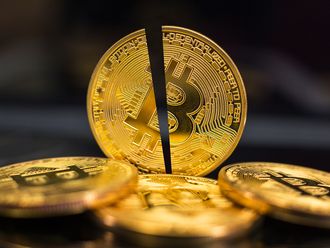
Dubai: Since 2021 began, there were several mentions of the word ‘SPAC’ in the world of business and investments. But since the start of this year, there haven’t been much talk on this so-called boom. Did this up and coming trend fizzle out?
However, following a boom in 2021, it is officially a thing of the past. Not a single special purpose acquisition company was issued in July as the market slowdown turned into a screeching halt, according to CNBC calculations of SPAC Research data.
2021 was a spectacular year for SPACs
Although SPACs were first created in the 1990s, they didn’t gain popularity with investors until last year. There were 302 SPAC deals throughout 2021 worldwide with $622.9 billion (Dh2.29 trillion) invested, a year-on-year surge of over 152 per cent.
The SPAC boom witnessed last year in the US fizzled out in 2022, dropping from $231.3 billion (Dh849 billion) in 2021, to $26.3 billion (Dh96.60 billion) so far this year. Similar trends were witnessed elsewhere in the world.
2022 a disappointing year for SPACs
Only one SPAC was launched in Hong Kong in the first quarter and it raised $128 million (Dh470 million), while three were launched in Singapore, raising a total of $334 million (Dh1.2 billion), according to global data analytics firm Refinitiv.
“Although the investments still trickle in for SPACs, it’s only likely reflective of investors being happy to play a game of patience, rather than investors who in recent years chased SPACs higher in the hope they would acquire a ‘hot’ start-up,” said Brody Dunn, an investment manager at a UAE-based asset advisory firm.

That means most of the SPACs that went public during the pandemic are still too new to have completed their deals. In fact, 82 per cent of 2021 SPACs are still searching for deals, with only around 3 per cent that completed a business combination already.
Should you write off SPACs completely? Not yet
However, this hasn’t stopped some SPACs from finding acquisition targets quickly. On average, a SPAC that listed in 2021 and completed an acquisition was only just over 7.5 months. That trend is consistent with the slightly older SPACs from 2020, which have also averaged less than one year to complete.
Moreover, since February 2021, when the SPAC craze was booming, a market sell-off has wiped out about $75 billion (Dh275 billion) of the value of companies that went public using SPACs, according to an analysis that examined a group of 137 companies that went public using SPACs by mid-February this year.
Does this mean investors are to stay clear?
According to the analysis, these companies have lost 25 per cent of their combined value since then. Over the same period, the global stock markets gained 13 per cent – making stocks a better investment than putting your money in SPACs.
But that is not to say that SPACs still don’t offer a decent-sized stock market return. In between SPAC IPO and merger, the average return for SPAC investors has been 9.3 per cent a-year since 2010, according to figures from a January 2021 Goldman Sachs report.
“From the perspective of the acquired company, the SPAC process provides several benefits for investors and business owners, one of which is the ability for earlier stage companies to go public – an opportune moment for investors to buy stocks at par value,” said Dunn noted.

Don’t invest hoping for short-term profits
While these companies generally have lower revenue and less-established business models, and are still incurring significant losses, it provides for market certainty on the share price at which the firm goes public, especially in volatile market conditions as the acquisition price is pre-negotiated with the SPAC.
“Although SPACs provide access to experienced managers from the SPAC that can guide the firm in its growth phase after it goes public – that’s still isn’t hard-proof. In reality, if the losses continue to rise, it makes it a risky short-term investment, which is why new investors have been hesitant to go all in,” added Dunn.
Given SPAC's poor track record, veteran investors and market analysts are still widely of the opinion that investors should be wary of investing in them, unless they focus their investing on pre-acquisition SPACs when the listed prices are low.
However, while among those analysts that believe profitably investing in SPACs is possible, they reiterate that manually selecting them is essential, as compared to selecting the SPAC through robo-advisors.
Investing in a SPAC IPO is still a bet on the sponsors
As with any investment decision, there are perks and risks to investing in a SPAC. Investing in a SPAC IPO amounts to a bet on the sponsors or the SPAC owners, their reputation and whether a successful deal will happen within two years.
Rather than researching a company’s financials, as you should when investing in an individual stock, you will need to instead research who is behind the SPAC and what industry they may be targeting for an acquisition.
Experienced investors may use their industry expertise to back the most skilled sponsors, who are likely to have the highest probability of success.

Selecting individual SPACs allows investors to focus on the opportunities that seem most promising. If you can't access a SPAC's pre-IPO stock, you can still invest in pre-deal SPAC stock after it goes public. SPAC stocks often soar after they announce a deal to merge with a private company. Once a SPAC debuts on the US-based stock exchanges (or any other) you can buy it through your regular broker.
Verdict: Buy SPACs now, or not to?
While SPACs do offer a guaranteed return of your investment if they don’t acquire or merge with a company within two years, they aren’t without risk.
First, though most SPACs start out with share prices of around $10 (Dh36), this price can rise substantially due to the fame of those behind them or the announcement of their target acquisitions.
If you end up paying more than the initial offering price of a SPAC, you could stand to lose more than your initial investment if no deal materialises since you would only recover the $10 (Dh36) per share price, after deducting expenses.
And if your SPAC does successfully acquire a company, it becomes just as risky as any other single stock, if not riskier. So keep in mind that while some start-ups offer incredible returns on investment, most fail or offer sub-par returns. Perhaps the boom for SPACs is over?











